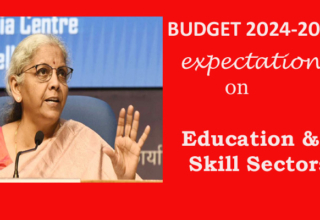
The Government, as it finalizes the Union Budget, will do well to remember that the designers of today are the innovators and entrepreneurs of tomorrow, and it would do well to invest in this intrepid breed of dreamers if we are to achieve our collective dream of a $5 trillion economy.

Given the disruption induced by technology (4th Industrial Revolution), any move to stimulate overall economic activity and create employment will have to involve design. The Government’s ‘Make-in-India’ initiative needs to be coupled with a ‘Design-in-India’ push so people can create new products, devise business processes, and think about new ways of service delivery for society. This is a must so that we can build a more “skilled” and “employable” India because the fact remains that the design industry is today one of the major employers as all industry verticals are augmenting their design & innovation capacities. Yet the importance of the design industry and education and its contribution to the GDP and nation building is hardly recognized. For this to happen, the Government needs to change its mindset and that of the populace. It can make a beginning by incorporating more creative learning into the secondary education curriculum and setting up a creative think-tank that challenges policy and re-writes the rules. Creating a role in the Cabinet for the creative industries would give a fillip to the sector and hence employment.
In South Korea they have formed a Ministry for Future, Sciences and Creativity. This underlines the important role that design plays there in transforming science into culture. I think in India too we need a similar initiative that can bring together science, technology and creativity; and create a cross-cutting strategy that enables gaming, the visual art industry, the industrial design sector, the music sector, the communication sector, and the creative-industrial areas that emerge from their hybridisation to be integrated into the consolidation of technological research with economic development. In fact, the Government in its Budget must adopt a business-focused approach to help Indian designers coming out of the HEIs to secure work. Every industry segment, from craft to MSMEs, from manufacturing to services, from IT to banking & finance can benefit from design intervention and become engines of economic growth.
Design also opens the door to Research and Development (R&D), particularly for MSMEs who with their limited resources can’t include R&D in their business model. The Government would do well to invest in research that promotes deeper appreciation of the ‘steppingstones to R&D’ like design.
Investing in creative skills right from the primary education sector to higher education and professional training, will result in widespread innovation and in turn, a boost to our economy. The value of design skills cannot be overemphasized in fueling the growth engine of the economy. But for this to happen the Government should focus on forming a “mission” of embedding these skills across the nation and this can only be done by providing a much-needed fillip to design education in the country. Increased funding would enable creative education providers in India to make quality higher education affordable for all, making them more employable and fulfilling the Centre’s objective of providing jobs to the youth of the country.
Any serious effort about creating employment opportunities would require a shift in the focus on encouraging creativity along with the stress on sciences. This is because unprecedented changes are taking place and newer opportunities are emerging. A Metaverse is being imagined and created, opening a completely new universe of opportunities for game designers, producers, storytellers, data providers, analysts, spatial mappers, public health and safety experts besides teachers, coaches and leaders. The art and design world of the future would be making full use of present and future, augmented and virtual reality technologies.
The education for this emerging new age also needs to be current with the demand. The government mission should be to make design, creativity and innovation as important to the school curriculum as math and English, strengthen higher education institutions in the field of design so that in the coming two decades we produce a whole new generation of home-grown companies and unicorns; and we are able to produce as many creative directors as financial directors.
The Government, as it finalizes the Union Budget, will do well to remember that the designers of today are the innovators and entrepreneurs of tomorrow, and it would do well to invest in this intrepid breed of dreamers if we are to achieve our collective dream of a $5 trillion economy.
No one had expected the pandemic to continue for as long as it has done and along with India Inc. the education sector has suffered too. Those involved in imparting skills and education, particularly in the creative field, have had to meet unprecedented challenges. Classroom education was disrupted, replaced by online teaching in the early days of the Covid outbreak and eventually turned into a combination of online and offline learning.
The online and hybrid mode of education has put immense financial stress on higher education institutions (HEIs), and more so on students in tier 2 and tier 3 cities. Those institutions offering education in the creative domain have struggled to create the required pedagogical infrastructure and in bridging the digital divide.
A major expectation of HEIs therefore is about addressal of the problem of financial stress on HEIs & students on account of shifting to online mode. Government support will be required in creating the vital infrastructure and financing the costs of extra training and skill development, as also the cost of various Edtech platforms required to keep the online education going.










